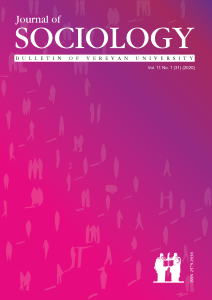Roles Defined Through Language: A Comparative Analysis of Nouns Denoting Family Relations in Armenian, Italian and English Languages
DOI:
https://doi.org/10.46991/BYSU:F/2020.11.1.048Keywords:
Selected:sociolinguistics, comparative analysis, English, Italian, Armenian, family relations, A. Giddens, B. Bernstein, sociologyAbstract
The article attempts to compare nouns expressing family relations in Armenian, Italian and English, and to identify the social foundations of their existence. The research methodology is based on the theoretical approaches of sociologists E. Giddens and B. Bernstein, which allow us to explain a number of thematic research issues. The article provides a comparative table of nouns expressing family relations in the three languages under consideration, and gives a detailed interpretation of this in relation to a number of social characteristics
References
Coupland, N., Sarangi, S. & Candlin, C. (2001) Sociolinguistics and Social Theory, Longman, University of Michigan, p. 30.
Levi-Strauss, Cl. (1951) Language and the Analysis of Social Laws, American Anthropologist, New Series, Vol. 53, No. 2, pp. 155-163. Doi: https://doi.org/10.1525/aa.1951.53.2.02a00010
Coupland, N. (2007) Style: Language variation and identity, Cambridge, New York: Cambridge University Press, 2007, p. 128. Doi: https://doi.org/10.1017/CBO9780511755064
Giddens, A. (1984) The Constitution of Society. Outline of the Theory of Structuration. University of California Press.
Poole, M. (2013) Structuration Research on Group Communication, Management Communication Quarterly. 27, 4, pp. 607-614. Doi: https://doi.org/10.1177/0893318913506265
Poole, M. (1997) The Small Group Should Be the Fundamental Unit of Communication Research. In Trent, J. (Ed.), Communication: Views from the Helm for the 21st Century, Boston, MA: Allyn & Bacon, pp. 94-97.
McPhee, R., Poole, M. & Iverson, J. (2014) Structuration Theory In Putnam, L. & Mumby, D. (Ed.), The SAGE Handbook of Organizational Communication: Advances in Theory, Research and Methods, pp. 75-101.
Albano, R., Masino, G. & Magi, B. (2010) The Relevance of Giddens' Struturation Theory for Organizational Research, TAO Digital Library, Bologna.
Jones, M. R. & Karsten, H.(2008) Giddens’s Structuration Theory and Information Systems Research. MIS Quarterly, 32(1), 127–157. Doi: https://doi.org/10.2307/25148831
Pozzebon, M. & Pinsonneault, A. (2005) Challenges in Conducting Empirical Work Using Structuration Theory: Learning from IT research. Organization Studies 26 (9), pp. 1353-1376. Doi: https://doi.org/10.1177/0170840605054621
Bernstein, B. (1971) Class, Codes and Control (Volume 1) Theoretical Studies Towards a Sociology of Language. London: Routledge & Kegan Paul.
Zhao, W (2014) The Implications of Bernstein’s Theory of Codes on Contemporary Chinese Education, Canadian Social Science Vol. 10, No. 6, pp. 99-103.
Halliday, M. (2014) Language and the Theory of Codes. A. Sadovnik (Ed.) Knowledge and Pedagogy: The Sociology of Basil Bernstein. Westport, CT: Greenwood Publishing Group.
Maton, K. & Muller, J. (2007) A sociology for the transmission of knowledges, Christie, F. & Martin, J. (eds) Language, Knowledge and Pedagogy. London, Continuum, pp. 14–33.
Bernstein, B. (2010) A Public Language: Some Sociological Implications of a Linguistic Form, The British Journal of Sociology, Vol. 61. Doi: https://doi.org/10.1111/j.1468-4446.2009.01240.x
Bruner, J., Goodrow, J. & Austin, A. (1957) A Study of Thinking, Wiley. Doi: https://doi.org/10.2307/1292061
Davis, A. et al (1951) Intelligence and Cultural Differences, University of Chicago Press.
Bott, E. (2001) Family and Social Network: Roles, Norms and External Relationships in Ordinary Urban Families, Routledge, p.3.
Bernstein, B. (1990) Class, Codes and Control (Volume 4) The Structuring of Pedagogic Discourse, p. 101.
Newman, D. & Grauerholz, L. (2002) Sociology of Families, SAGE Publications, p. 7.
Brown S. (2016) Relationship Terms, Oak Road Systems.
Downloads
Published
How to Cite
Issue
Section
License
Copyright (c) 2020 Ofelia Grigoryan

This work is licensed under a Creative Commons Attribution-NonCommercial 4.0 International License.








